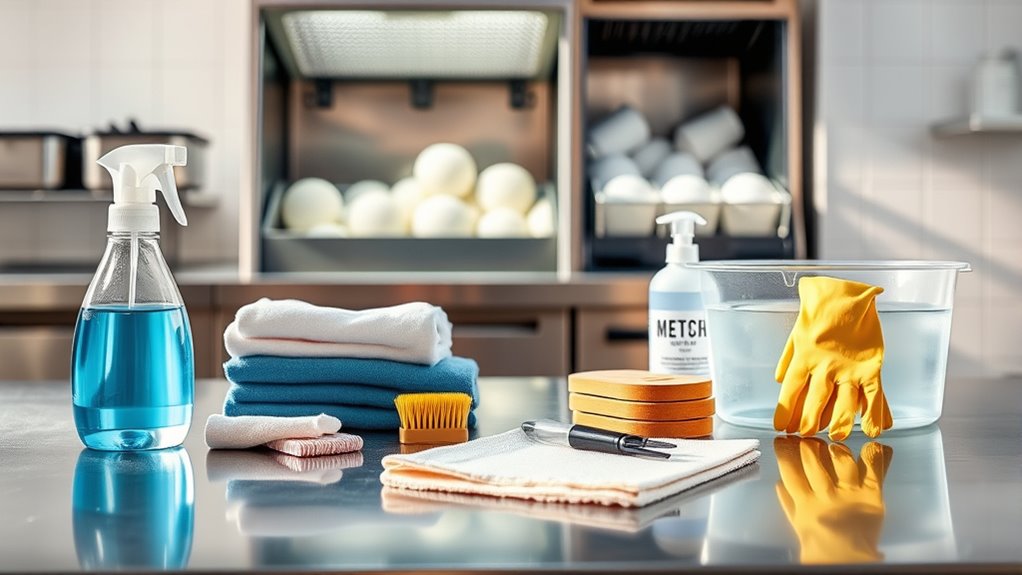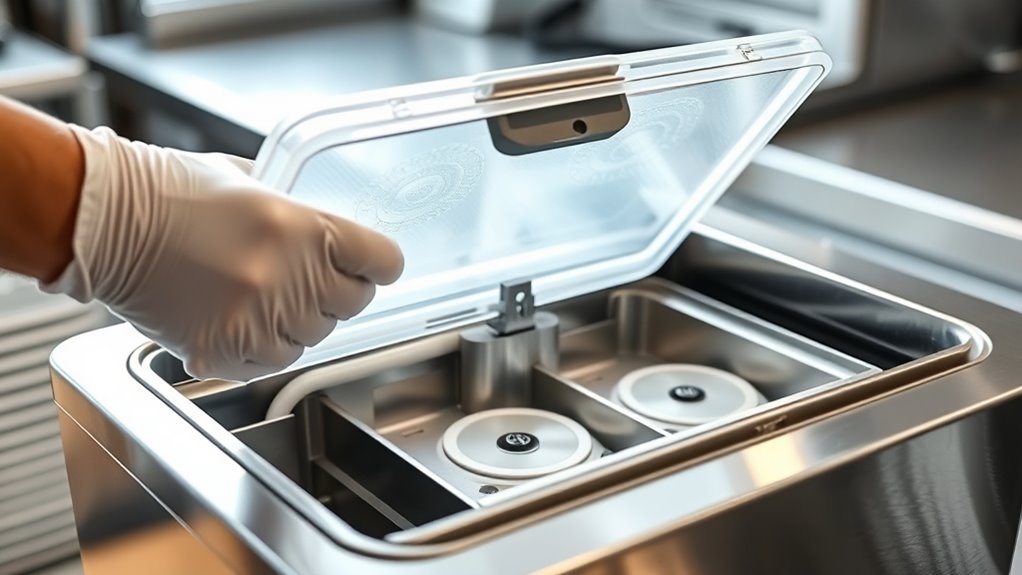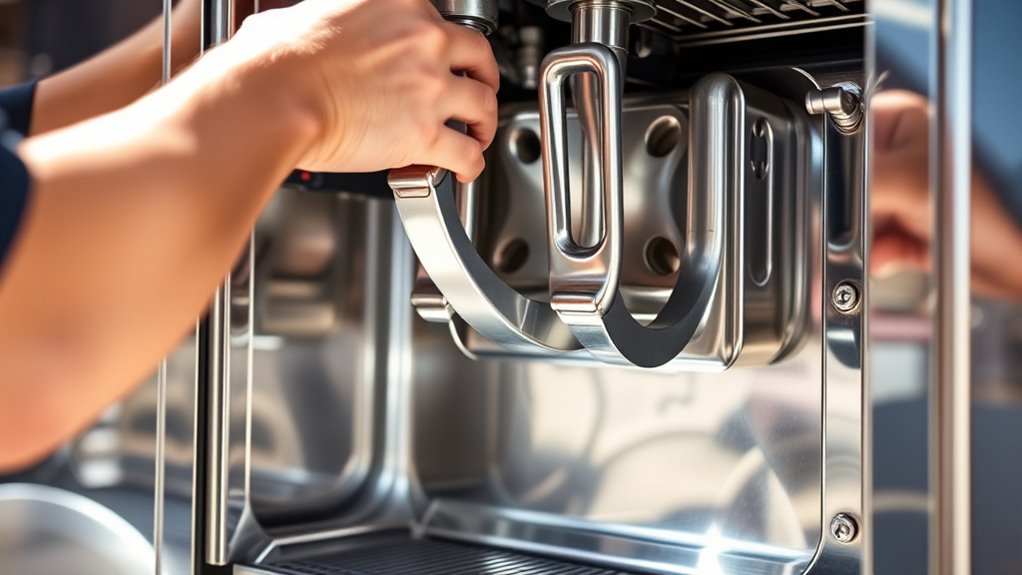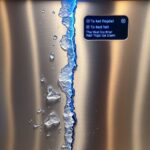To clean your commercial ice cream machine effectively, start by gathering all supplies and preparing your workspace. Turn off and carefully disassemble the machine, then thoroughly clean and sanitize every component, paying close attention to hard-to-reach areas and seals. Reassemble the parts, run a test cycle, and verify everything works smoothly. Staying consistent with this routine extends your equipment’s life and maintains product quality—if you keep going, you’ll learn more tips to keep your machine in top shape.
Key Takeaways
- Turn off, unplug, and carefully disassemble the machine following manufacturer instructions for safety and proper component removal.
- Thoroughly clean and sanitize all parts, including hard-to-reach areas and seals, using food-safe disinfectants.
- Inspect seals and gaskets regularly, replace worn parts, and use appropriate lubricants to maintain hygiene and prevent leaks.
- Reassemble the machine securely, then run a test cycle to check for leaks, noises, and proper calibration before serving.
- Establish a routine cleaning and maintenance schedule to prevent bacteria buildup, prolong equipment lifespan, and ensure consistent quality.
Gather the Necessary Cleaning Supplies and Prepare Your Workspace

Before you begin cleaning your commercial ice cream machine, it is vital to gather all the necessary supplies and set up your workspace. Start by collecting cleaning solutions, brushes, towels, and sanitizers. Having everything within reach guarantees you can follow proper cleaning techniques without interruption. Make sure your cleaning supplies are suitable for your equipment type to prevent damage. Check that the machine’s components are properly calibrated, ensuring peak performance after cleaning. Equipment calibration is essential to maintain consistent ice cream quality and prevent issues caused by misaligned parts. Organize your workspace for efficiency and safety, clearing clutter and preparing a designated area for disassembled parts. This preparation helps you clean thoroughly, avoid mistakes, and keep your machine running smoothly.
Turn Off and Disassemble Your Ice Cream Machine Carefully

To guarantee safety and prevent damage, you should turn off your ice cream machine and disconnect it from the power source before disassembling it. Proper machine safety is essential to avoid electrical hazards and mechanical injuries. Ensure you’ve received adequate operator training so you understand the disassembly process and recognize potential risks. Carefully remove panels and components, following the manufacturer’s instructions. Handle parts gently to avoid damage, and keep track of all screws and small pieces. Remember, rushing can lead to mistakes or injuries. Disconnecting the power and disassembling with attention to detail not only protects you but also preserves the machine’s integrity. Being aware of machine design considerations can help prevent accidental damage during maintenance. Additionally, understanding the essential oil properties relevant to cleaning solutions can enhance sanitation effectiveness. Familiarity with proper cleaning procedures can also improve overall hygiene and prolong the lifespan of your equipment. Incorporating water management techniques can further optimize cleaning and maintenance routines, ensuring your machine remains in top condition. Paying attention to sound healing science can even help reduce stress during maintenance routines, making the process smoother. Taking these precautions makes the cleaning process safer and more effective, setting the stage for thorough sanitation later.
Clean and Sanitize All Components Thoroughly

You need to remove all parts of the machine carefully to guarantee a thorough cleaning. Use a proper sanitizer to eliminate bacteria and prevent contamination. Make sure every component is cleaned and sanitized before reassembling. Additionally, paying attention to effective sanitation practices can help ensure the safety and longevity of your ice cream machine. Regular maintenance and adherence to cookie consent management guidelines can also contribute to optimal operation and compliance with privacy standards. Remember that following proper divorce process procedures in your state can also prevent complications and ensure a smoother resolution. Recognizing signs of angel numbers during your maintenance routines can serve as subtle reminders to stay attentive and mindful of the importance of thorough cleaning. Incorporating the use of appropriate cleaning agents tailored specifically for dairy equipment can further enhance sanitation results and reduce the risk of residual buildup.
Subheading 1: Remove All Parts
Removing all parts of your commercial ice cream machine is the essential first step in the cleaning process. This allows you to access every component for thorough cleaning and effective machine maintenance. Follow these steps:
- Turn off and unplug the machine to ensure safety.
- Detach the auger, dasher, and freezing bowl carefully.
- Remove the lid, chute, and external panels for detailed cleaning.
- Check for any loose or damaged parts that may need replacement.
Subheading 2: Use Proper Sanitizer
After removing all the parts, it’s crucial to thoroughly clean and sanitize each component with the proper sanitizer. Using the right sanitizing techniques ensures your machine stays hygienic and safe for customers. Choose a proper sanitizer compatible with food equipment and follow the manufacturer’s instructions carefully. Apply it to all surfaces, paying attention to hard-to-reach areas. Let the sanitizer sit for the recommended contact time before rinsing if needed. Proper sanitizing not only kills bacteria but also prevents buildup that can affect ice cream quality. Regular use of food-safe sanitizers helps maintain a hygienic environment and extends the lifespan of your equipment. Remember, effective sanitizing is key to maintaining a clean machine and complying with health standards. Incorporating regular maintenance into your cleaning routine helps sustain optimal performance and hygiene standards. Additionally, ensure that you are aware of cookie consent requirements to protect user privacy during your cleaning procedures.
Pay Special Attention to Hard-to-Reach Areas and Seals

Make sure you access all those tight spots and hidden corners that can trap dirt and bacteria. Pay close attention to seals, as they can harbor mold and residue if not cleaned properly. Regularly inspect and maintain seals to keep your machine running smoothly and hygienically. Utilizing specialized cleaning tools designed for tight spaces can help ensure thorough sanitation and prevent buildup. Additionally, understanding performance upgrades can inform maintenance routines to keep your equipment operating efficiently. Incorporating preventive maintenance practices can further extend the lifespan of your commercial ice cream machine. Staying informed about hygienic practices and industry standards further ensures optimal cleanliness and safety.
Accessing Hidden Spots
To make certain your ice cream machine is thoroughly cleaned, it’s essential to pay close attention to hard-to-reach areas and seals that often trap residues. These hidden corners and inaccessible spots can harbor bacteria if neglected. To access these areas effectively:
- Use small brushes or toothbrushes to reach tight spaces.
- Remove panels carefully to expose hidden components.
- Check behind gaskets and seals for buildup.
- Use a mirror or flashlight to spot overlooked areas.
- Regular maintenance and inspection can prevent the buildup of residues and ensure optimal hygiene and performance. Incorporating proper cleaning techniques can further enhance the effectiveness of your sanitation routine. Additionally, understanding the importance of preventive maintenance can inspire better organization and cleanliness practices in your space.
Seal Maintenance Tips
Since seals and hard-to-reach areas are prone to trapping residues and mold, maintaining them regularly is essential for cleanliness and machine longevity. Start by inspecting the seals carefully for any signs of wear, cracks, or buildup. Proper seal inspection ensures you catch issues early and prevent leaks or contamination. Next, apply a food-grade seal lubrication to keep the seals flexible and functioning smoothly. Avoid over-lubricating, which can attract debris. When cleaning, pay close attention to the tight corners and edges around the seals, ensuring no residue remains. Regular inspection and lubrication help prevent mold growth, maintain proper sealing, and extend your machine’s lifespan. Incorporating seal durability considerations into your maintenance routine can help you select the best materials for your machine’s seals, ensuring they withstand regular cleaning and use. Additionally, understanding the importance of seal materials can lead to choosing options that resist wear and chemical damage over time. Utilizing automated cleaning systems can further streamline your maintenance process, ensuring thorough cleaning of those hard-to-reach areas.
Reassemble the Machine and Perform a Test Run

After thoroughly cleaning and inspecting all parts, it’s time to reassemble the machine carefully. Make sure each component fits snugly and securely. Once reassembled, perform a test run to verify everything functions properly. During this process, focus on the following steps:
- Check that the machine calibration is accurate for ideal ice cream consistency.
- Run the machine without product to verify there are no leaks or unusual noises.
- Observe the consistency and texture of the ice cream during the test.
- Gather customer feedback during initial servings to identify any issues with flavor or texture.
This process ensures your machine operates smoothly and meets customer expectations, keeping your business running efficiently and your customers happy.
Establish a Regular Cleaning Schedule for Optimal Performance

Once you’ve reassembled your ice cream machine and confirmed it operates smoothly, establishing a regular cleaning schedule becomes essential for maintaining its performance. Consistent cleaning schedules prevent buildup, bacteria growth, and equipment breakdowns. Develop a routine that fits your operation’s volume—daily, weekly, or monthly—and stick to it. Incorporate specific tasks like sanitizing parts, cleaning nozzles, and checking for wear. Well-planned maintenance routines not only extend your machine’s lifespan but also ensure the highest-quality ice cream for your customers. Keep a cleaning log to track completed tasks and identify any issues early. By staying disciplined with your cleaning schedules, you’ll keep your machine running efficiently and reduce costly repairs down the line.
Frequently Asked Questions
How Often Should I Deep Clean My Commercial Ice Cream Machine?
You should deep clean your commercial ice cream machine regularly to maintain hygiene and product quality. The ideal cleaning frequency depends on usage, but generally, a deep cleaning schedule recommends doing it at least every 24 to 48 hours if you serve many customers daily. If you use it less often, cleaning weekly might suffice. Consistently following this schedule prevents buildup and guarantees your machine operates smoothly and safely.
Can I Use Regular Kitchen Cleaning Products on Machine Components?
You might wonder if regular kitchen cleaning products are safe for your machine components. It’s best to check product compatibility first, as some kitchen cleaners can damage ice cream machine parts. Using the wrong products could lead to corrosion or residue buildup, affecting performance. Always opt for cleaning solutions specifically designed for commercial ice cream machines, ensuring effective cleaning without risking equipment damage or compromising hygiene.
What Are the Signs My Ice Cream Machine Needs Professional Servicing?
You’ll notice your ice cream quality declines, with inconsistent textures or strange flavors, signaling it’s time for professional servicing. Also, if the machine takes longer to freeze or shows leaks, these are warning signs that your machine’s lifespan could be at risk. Regular maintenance keeps your equipment running smoothly and guarantees your ice cream stays first-rate, ultimately protecting your investment and extending its longevity.
How Do I Prevent Mold Buildup During Cleaning?
To prevent mold buildup, you should establish a consistent cleaning schedule and use mold resistant coatings on your machine’s components. Regularly wipe down all surfaces, paying special attention to hard-to-reach areas, and guarantee thorough drying afterward. Applying mold resistant coatings can help inhibit mold growth. Staying proactive with these steps keeps your machine hygienic, reduces mold risks, and ensures your ice cream stays fresh and safe for customers.
Is It Necessary to Wear Protective Gear During Cleaning?
You might think protective gear slows you down, but it’s essential for cleaning safety. Wearing gloves and goggles safeguards you from cleaning chemicals and potential mold spores, reducing health risks. Skipping protective gear can lead to skin irritation or eye injury. Prioritize your safety by always using protective gear during cleaning. It’s a small step that ensures you stay safe and healthy while maintaining your equipment effectively.
Conclusion
By keeping your ice cream machine spotless, you’re ensuring it runs like a well-oiled machine in a symphony of cleanliness. Regular maintenance acts as the heart’s steady beat, preventing buildup and prolonging its life. Think of cleaning as tending to a garden—you nurture it regularly, and it rewards you with delicious, perfect treats every time. Stay consistent, and your machine will serve up sweet success, season after season.
















